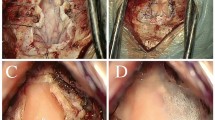Abstract
The benefits of osteoplastic suboccipital craniotomies over the traditional suboccipital craniectomies have been recognized. We describe a simple method of expansive suboccipital cranioplastic craniotomy using a free bone flap and report satisfactory clinical results in 16 patients with syringomyelia associated with Chiari I malformation. A free suboccipital bone flap is created from the rostral part of the occiput by placing two to four burr holes and connecting them with a craniotome. The posterior bony margin of the foramen magnum and the posterior arch of C1 are removed thereafter. Then dural plasty using a patch graft of dural substitutes is performed. The expansive suboccipital cranioplasty is performed by positioning the free bone flap caudal to the original location and fixing it with titanium miniplates to construct a bony frame to cover the foramen magnum. The rostral part of the cranial defect is filled with bone chips created during the craniotomy. Sixteen patients underwent this procedure. There was no operative mortality and no major complication, such as persistent pseudomeningocele. Preoperative symptoms improved significantly in all patients except for one who had persistent dysesthetic pain. Our simple method of expansive suboccipital cranioplasty for the treatment of syringomyelia associated with Chiari I malformation proved useful and achieved satisfactory long-term results.




Similar content being viewed by others
References
Cristane L, Westphal M, Hermann H-D (1994) Cranio-cervical decompression for Chiari I malformation. Acta Neurochir (Wien) 130:94–100
Gnanalingham KK, Lafuente J, Thompson D, Harkness W, Hayward R (2002) Surgical procedures for posterior fossa tumors in children: does craniotomy lead to fewer complications than craniectomy? J Neurosurg 97:821–826
Hida K, Iwasaki Y, Koyanagi I, Sawamura Y, Abe H (1995) Surgical indication and results of foramen magnum decompression versus syringosubarachnoid shunting for syringomyelia associated with Chiari I malformation. Neurosurgery 37:673–679
Holly LT, Batzdorf U (2001) Management of cerebellar ptosis following craniovertebral decompression for Chiari I malformation. J Neurosurg 94:21–26
Isu T, Sasaki H, Takamura H, Kobayashi N (1993) Foramen magnum decompression with removal of the outer layer of the dura as treatment for syringomyelia occurring with Chiari I malformation. Neurosurgery 33:845–850
Matsumoto T, Symon L (1989) Surgical management of syringomyelia—current results. Surg Neurol 32:258–265
Milhorat TH, Kotzen RM, MU HTM, Capocelli AL, Milhorat RH Jr (1996) Dysesthetic pain in patients with syringomyelia. Neurosurgery 38:940–947
Nishikawa M, Sakamoto H, Hakuba A, Nakanishi N, Inoue Y (1997) Pathogenesis of Chiari malformation: a morphometric study of the posterior cranial fossa. J Neurosurg 86:40–47
Oldfield EH, Muraszko K, Shawker TH, Patronas NJ (1994) Pathophysiology of syringomyelia associated with Chiari I malformation. J Neurosurg 80:3–15
Paul KS, Lye RH, Strang FA, Dutton J (1983) Arnold–Chiari malformation. J Neurosurg 58:183–187
Sahuquillo J, Rubio E, Poca M-A, Rovira A, Rodriguez-Baeza A, Cervera C (1994) Posterior fossa reconstruction: a surgical technique for the treatment of Chiari I malformation and Chiari I/syringomyelia complex—preliminary results and magnetic resonance imaging quantitative assessment of hindbrain migration. Neurosurgery 35:874–885
Sakamoto H, Nishikawa M, Hakuba A, Yasui T, Kitano S, Nakanishi N, Inoue Y (1999) Expansive suboccipital cranioplasty for the treatment of syringomyelia associated with Chiari malformation. Acta Neurochir (Wien) 141:949–961
Takayasu M, Nishizawa T, Yoshida J (2001) Simple expansive suboccipital cranioplasty following foramen magnum decompression for the treatment of syringomyelia associated with Chiari I malformation. In: Tamaki N, Batzdorf U, Nagashima T (eds) Syringomyelia, current concepts in pathogenesis and management. Springer, Tokyo, pp 159–163
Tokuno H, Hakuba A, Suzuki T, Nishikawa S (1998) Operative treatment of Chiari malformation with syringomyelia. Acta Neurochir Suppl 43:22–25
Williams B (1986) Progress in syringomyelia. Neurol Res 8:130–145
Author information
Authors and Affiliations
Corresponding author
Rights and permissions
About this article
Cite this article
Takayasu, M., Takagi, T., Hara, M. et al. A simple technique for expansive suboccipital cranioplasty following foramen magnum decompression for the treatment of syringomyelia associated with Chiari I malformation. Neurosurg Rev 27, 173–177 (2004). https://doi.org/10.1007/s10143-004-0338-5
Received:
Accepted:
Published:
Issue Date:
DOI: https://doi.org/10.1007/s10143-004-0338-5




